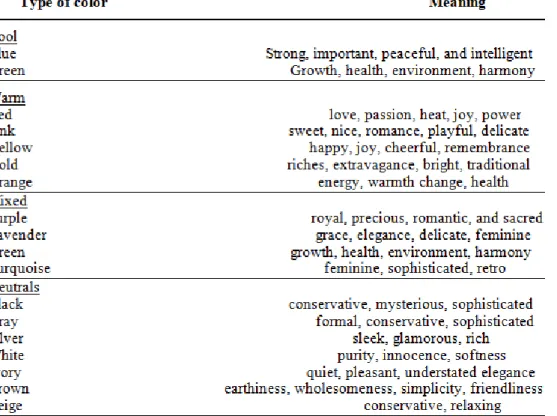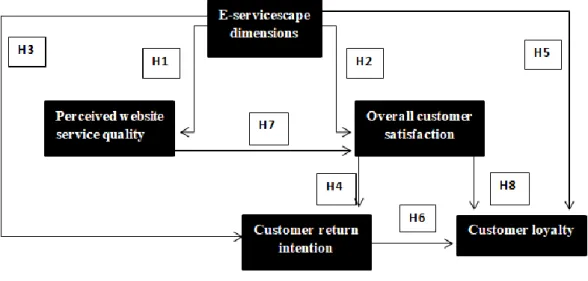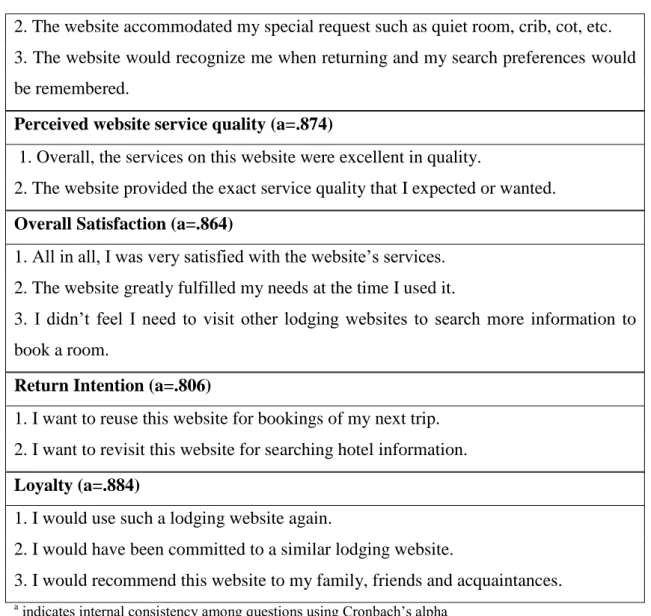The purpose of this study is to determine the relationships between the e-servicescape dimensions and the constructs of website quality perception, customer satisfaction, return intention, and customer loyalty. In summary, the findings of this study provided evidence that e-servicescape dimensions were directly related to customer-perceived website service quality dimensions, customer retention, overall customer satisfaction, and customer loyalty to a hotel-owned website.
- The concept of Intangibility in services
- Perceived risk related with intangible nature of services
- Internet presence-The emergence of Internet in the Hotel industry
- Greek hotels
- E-commerce on a hotel website: Benefits-Consequences
- Website design and Marketing
- Hotel website management and Marketing
- Online booking channels
Finally, the service sector not only facilitates but also enables the goods-producing activities of the manufacturing sectors. The service customer is only exposed to a limited number of signals due to the intangible nature of services.
REVIEW
Physical representation: Serviscape-Definition-Dimensions
Functionality is related to the ability of the same elements to facilitate the provision of services. Signs, symbols and artifacts represent implicit or explicit signals that inform visitors about a place.
E-Servicescape: Definition-Role
- E- Servicescape dimensions
It is suggested that the originality of the website design enhances the visual appeal (using creative logos, right colors, using appropriate backgrounds and appropriate typography present on the website), as well as it seems to be very useful for online customers the variety of colors relating to different functions (Fink & Laupse 2000; Koo & Ju, 2009). From her side, the entertainment value (entertaining customers through the creation of an appealing, exciting and fun environment) of the website also facilitates enhancing the visual appeal (Eroglu et al., 2001).
Classic Servicescape concept vs. e-Servicescape
The security systems must be strict and remove the customer's doubts about whether to carry out a transaction or not.
Website elements
- Content & Design of Websites
- Website personality
- First impression of a website
In addition, the progress of the page can be determined by the number of features available on a website (all the six features mentioned above). The first feature of website design is the navigation structure: by adding or skipping links between pages, web designers prescribe a structure and forms that can influence search.

Website quality- Definition- Dimensions
- Online decision making
- Measurement of service quality delivery through websites
- Aesthetics
- Usability
- Interactivity
- Useful information
- Personalization/ Customization
- Accessibility
- Privacy/ Security
Proposed by Mathwick et al (2001), the aesthetic dimension of the experiential value is further subsumed into two elements, visual appeal and entertainment. This research on the visual aesthetics of website context indicated that the overall impression of the website is estimated according to the level of beauty and that the visual attractiveness is highly associated with the entertainment of the user, the perceptions of ease of use of the website and consequently the usefulness potentially derived from website use (Schenkman and Johnson, 2000). Website accessibility is associated with the ability of online users to access resources of the website.
Kim and Lee (2004) recommended that privacy/security include transaction features with the aim of making customers feel that using the website is simple and user-friendly in performing the transactions. Therefore, the website's trust concept is dependent on the level of positive impressions of customer interactions with the firm, followed by vulnerability accepted by customers.

Customer satisfaction
So far, many researchers have verified that customer satisfaction is initially a function of perceived overall service quality (Cronin & Taylor, 1994; Chang, 2005). According to the aforementioned two categories of customer satisfaction, such as transaction satisfaction and overall satisfaction, overall customer satisfaction reflects the cumulative impression of service providers' performance and can further be a predictor of customer loyalty. Anderson and Srinivasan (2003) researched the impact of customer satisfaction on customer loyalty in an e-commerce context and defined e-satisfaction as a customer's satisfaction with his previous shopping experience with a particular e-commerce company.
Anderson and Srinivasan (2003) gave their definition of e-satisfaction "as the satisfaction of the customer with respect to his or her previous purchase experience with a given electronic commerce firm" and added the opinion that dissatisfied customers are more likely to seek alternative information. search. , or redefine the relationship with the service provider as a satisfied customer. Oliver (1997) and Taylor & Baker (1994) explained that customer satisfaction and service quality are two different.
Customer Intention to Return-Retention
H3: The e-servicescape dimensions of a hotel-owned website are positively related to customers' intention to return to a particular website. H4: Overall customer satisfaction on a hotel-owned website is positively related to customers' intention to return to a particular website.
Customer Loyalty
Jones and Sasser (1995), suggested that customer loyalty is a customer's sense of belonging or identification with the employees, products/services of a firm, with these senses to have a direct impact on customer behavior. Customer loyalty is therefore a customer's sense of identification with a firm, with this sense influencing repurchase intentions, spending amount, the possibility of recommendation and even the willingness to become part of a business (Cheng, Shih-I, 2011) ). Keller (1993) introduced the concept of loyalty as the repeated purchase behavior for a period of time driven by a favorable attitude towards the subject and additionally.
H5: The e-servicescape dimensions of a hotel-owned website are positively related to customer loyalty to the particular site. H6: Customer return intention to a hotel-owned website is positively related to customer loyalty to the particular site.
Interrelationships
- Website service quality-customer satisfaction
- Customer satisfaction-customer loyalty
In the hospitality industry, much research has been done to analyze the relationship between customer satisfaction and customer loyalty (Getty &. Thompson, 1994; Kandampully & Suhartanto, 2003), proving that their relationship is almost intuitive in the overnight experiences. Customer satisfaction is the most discussed independent variable in customer loyalty studies (Ibanez et al., 2006; Auh and Johnson, 2005; Host & Knie-Anderson, 2004; Hellier et al., 2003). Reichheld and Saser (1990) state that increased customer satisfaction will affect the likelihood of repeat purchases.
Tailor and Baker (1994) specified that customer satisfaction is positively correlated with purchase intention while Fornell et al. 1996) also determined that the attitude of customer satisfaction is created immediately after customers have purchased merchandise or services. H8: Overall customer satisfaction with using a hotel-owned website is positively associated with customer loyalty.
A Conceptual Framework
Georgalas Sun Beach Resort: subject of research application
Since the company has adopted the online presence according to the flow of the online context of business worldwide, owns a website for the representation of the services provided, as well as the reservation of rooms. On the home page, the website visitor can find the representation of the company's offers included in different sections, each for a different purpose. Hotel Accommodation‖ tab the user of the website can find useful information about the different room types available and the equipment of each type of room, as well as next to information, a tab with direct booking order is also available as ―Book now‖.
In addition, with the second element of the menu "Villa Accommodation", the owner of the website clearly separates the existence of quality upgraded types of rooms that are also available, the "Villas", with the exact information of these facilities. Also available at the bottom of the website are useful links to other travel review websites.
- Methodology
- Sample
- Validity and reliability of research
- Survey Instrument Development
- Data collection
- Data Analysis
The aesthetic/design sub-dimension of e-serviscape practically and statistically significantly correlates with the personalization/customization sub-dimension (large effect; r=.549), perception of website service quality (large effect; r=.769), total customer satisfaction construct (large effect; r=.737), customer return intention construct (large effect; r=.740), customer loyalty construct (large effect; .r=.815). The personalization/customization sub-dimension of e-servicescape practically and statistically significantly correlates with the perception of the website service quality construct (large effect; r=.650), the overall customer satisfaction construct (large effect; r-.650), the construct of customer return intention (large effect; r=.549), customer loyalty construct (large effect; r=.548). The perception of the website quality construct correlates practically and statistically significantly with the general customer satisfaction construct (large effect; r=.810), the customer return-intention construct (large effect; r=.772), the customer loyalty construct (large effect; r=.805 ). ).
The overall customer satisfaction construct correlates practically and statistically significantly with the customer return intention construct (large effect; r=.794) and the customer loyalty construct (large effect; r=.812). Finally, the customer return intention construct correlates practically and statistically significantly with the customer loyalty construct (large effect; r=.849).

AND DISCUSSION
Discussion of results
Based on the theoretical literature review, six dimensions of the e-servisscape participate in the study as independent variables with the aim of investigating their relationship with the dependent variables: website service quality, overall customer satisfaction, retention customer and customer loyalty. It was hypothesized that the aforementioned six dimensions directly influenced the four dependent variables in the context of a hotel-owned website; The scales of the six sub-dimensions of e-serviscape attributes were composed to generate a single variable in order to access correlations with other dependent variables. Second, the relationship of website service quality as an independent variable is examined in terms of overall customer satisfaction, which in turn is examined in correlation to customer retention and customer loyalty.
Finally, the objective is to research the relationship of customer retention with customer loyalty. In particular, the e-servicescape dimensions positively influence the perception of website service quality, overall customer satisfaction, customer return intention and ultimately customer loyalty.
Implications of the study
An effective website design aims to benefit the business in terms of providing the highest quality of service to satisfy the customers, making them come back for another purchase and finally the ultimate goal of all businesses; to make customers loyal.
Limitations of the study
Later (March-April) destination, form of organization and period are widely considered, and finally, as summer approaches, more practical decisions are made, such as accommodation, activities, duration and transport. Therefore, the respondents in this study may not have paid much attention to the website's features, as seasonality did not arouse their desire for accommodation research.
Future Research
The role of the environment in services marketing: A consumer perspective: Chicago: American Marketing Association. Website quality and customer behavioral intention: An exploratory study of the role of information asymmetry. International issues in the design and use of e-commerce websites: the cases of hotels and airlines.
In Proceedings of the INTERACT'93 and CHI'93 conference on Human factors in computing systems (pp. 206-213). International Journal of Contemporary Hospitality Management, 23(1), pp.7-25.Tarn, J. The effects of service quality, perceived value and customer satisfaction on behavioral intentions. An online prepurchase intention model: The role of intention to search: Best Overall Paper Award—The Sixth Triennial AMS/ACRA Retail Conference, 2000☆ 1.
An assessment of the relationship between service quality and customer satisfaction in shaping consumers' purchase intentions.






